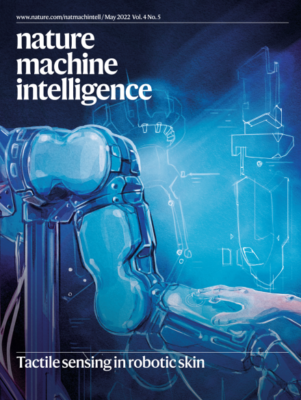
Collaborative robots are expected to physically interact with humans in daily living and the workplace, including industrial and healthcare settings. A key related enabling technology is tactile sensing, which currently requires addressing the outstanding scientific challenge to simultaneously detect contact location and intensity by means of soft conformable artificial skins adapting over large areas to the complex curved geometries of robot embodiments. In this work, the development of a large-area sensitive soft skin with a curved geometry is presented, allowing for robot total-body coverage through modular patches. The biomimetic skin consists of a soft polymeric matrix, resembling a human forearm, embedded with photonic fibre Bragg grating transducers, which partially mimics Ruffini mechanoreceptor functionality with diffuse, overlapping receptive fields. A convolutional neural network deep learning algorithm and a multigrid neuron integration process were implemented to decode the fibre Bragg grating sensor outputs for inference of contact force magnitude and localization through the skin surface. Results of 35 mN (interquartile range 56 mN) and 3.2 mm (interquartile range 2.3 mm) median errors were achieved for force and localization predictions, respectively. Demonstrations with an anthropomorphic arm pave the way towards artificial intelligence based integrated skins enabling safe human-robot cooperation via machine intelligence.
Authors: Massari, Luca; Fransvea, Giulia; D’Abbraccio, Jessica; Filosa, Mariangela; Terruso, Giuseppe; Aliperta, Andrea; D’Alesio, Giacomo; Zaltieri, Martina; Schena, Emiliano; Palermo, Eduardo; Sinibaldi, Edoardo; Oddo, Calogero Maria.

